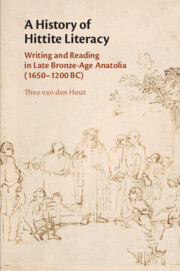Book contents
- A History of Hittite Literacy
- A History of Hittite Literacy
- Copyright page
- Dedication
- Contents
- Figures
- Tables
- Preface and Acknowledgments
- Map
- Timeline and Hittite Kings
- Sigla and Abbreviations
- Chapter 1 Introduction
- Chapter 2 Writing and Literacy among the Anatolians in the Old Assyrian Period
- Chapter 3 From Kanesh to Hattusa
- Chapter 4 First Writing in Hattusa
- Chapter 5 Literacy and Literature in the Old Kingdom until 1500 BC
- Chapter 6 The Emergence of Writing in Hittite
- Chapter 7 A Second Script
- Chapter 8 The New Kingdom Cuneiform Corpus
- Chapter 9 The New Kingdom Hieroglyphic Corpus
- Chapter 10 The Wooden Writing Boards
- Chapter 11 The Seal Impressions of the Westbau and Building D, and the Wooden Tablets
- Chapter 12 In the Hittite Chancellery and Tablet Collections
- Chapter 13 Scribes and Scholars
- Chapter 14 Excursus
- Chapter 15 The End and Looking Back
- Bibliography
- Index Locorum
- General Index
Chapter 7 - A Second Script
Published online by Cambridge University Press: 18 December 2020
- A History of Hittite Literacy
- A History of Hittite Literacy
- Copyright page
- Dedication
- Contents
- Figures
- Tables
- Preface and Acknowledgments
- Map
- Timeline and Hittite Kings
- Sigla and Abbreviations
- Chapter 1 Introduction
- Chapter 2 Writing and Literacy among the Anatolians in the Old Assyrian Period
- Chapter 3 From Kanesh to Hattusa
- Chapter 4 First Writing in Hattusa
- Chapter 5 Literacy and Literature in the Old Kingdom until 1500 BC
- Chapter 6 The Emergence of Writing in Hittite
- Chapter 7 A Second Script
- Chapter 8 The New Kingdom Cuneiform Corpus
- Chapter 9 The New Kingdom Hieroglyphic Corpus
- Chapter 10 The Wooden Writing Boards
- Chapter 11 The Seal Impressions of the Westbau and Building D, and the Wooden Tablets
- Chapter 12 In the Hittite Chancellery and Tablet Collections
- Chapter 13 Scribes and Scholars
- Chapter 14 Excursus
- Chapter 15 The End and Looking Back
- Bibliography
- Index Locorum
- General Index
Summary
Probably during the fifteenth century BC the Hittite ruling elite developed a second script, the Anatolian hieroglyphs, out of an already existing repertoire of symbols whose roots may go back to the Old Assyrian period. Egyptian inspiration for this script seems unlikely. Typologically, it fits in with an Aegaean script like Linear B but it may well be an originally Anatolian creation. Given the fact that the Luwian language became increasingly widespread within central Anatolia, that, where visible, Luwian is the language of the hieroglyphic inscriptions, and that the imported cuneiform and the Hittite language were never used for publicly displayed inscriptions, the creation and promotion of the hieroglyphs were part of the same attempt at unifying the kingdom. This chapter ends with a brief introduction to the Anatolian hieroglyphic script and system.
- Type
- Chapter
- Information
- A History of Hittite LiteracyWriting and Reading in Late Bronze-Age Anatolia (1650–1200 BC), pp. 120 - 138Publisher: Cambridge University PressPrint publication year: 2021

